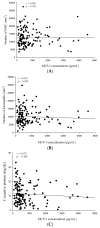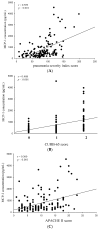Plasma Monocyte Chemoattractant Protein-1 Level as a Predictor of the Severity of Community-Acquired Pneumonia
- PMID: 26840299
- PMCID: PMC4783913
- DOI: 10.3390/ijms17020179
Plasma Monocyte Chemoattractant Protein-1 Level as a Predictor of the Severity of Community-Acquired Pneumonia
Abstract
Monocyte chemoattractant protein (MCP)-1 increases in the serum of immunocompetent patients with community-acquired pneumonia (CAP). However, the correlation between the circulating level of MCP-1 and severity of CAP remains unclear. This study investigated differential changes in the plasma MCP-1 levels of patients with CAP before and after an antibiotic treatment and further analyzes the association between the CAP severity and MCP-1 levels. We measured the plasma MCP-1 levels of 137 patients with CAP and 74 healthy controls by using a commercial enzyme-linked immunosorbent assay. Upon initial hospitalization, Acute Physiology and Chronic Health Evaluation II (APACHE II); confusion, urea level, respiratory rate, blood pressure, and age of >64 years (CURB-65); and pneumonia severity index (PSI) scores were determined for assessing the CAP severity in these patients. The antibiotic treatment reduced the number of white blood cells (WBCs) and neutrophils as well as the level of C-reactive protein (CRP) and MCP-1. The plasma MCP-1 level, but not the CRP level or WBC count, correlated with the CAP severity according to the PSI (r = 0.509, p < 0.001), CURB-65 (r = 0.468, p < 0.001), and APACHE II (r = 0.360, p < 0.001) scores. We concluded that MCP-1 levels act in the development of CAP and are involved in the severity of CAP.
Keywords: biochemical marker; community-acquired pneumonia; monocyte chemoattractant protein-1; pneumonia severity index.
Figures



Similar articles
-
Plasma long pentraxin 3 (PTX3) concentration is a novel marker of disease activity in patients with community-acquired pneumonia.Clin Chem Lab Med. 2013 Apr;51(4):907-13. doi: 10.1515/cclm-2012-0459. Clin Chem Lab Med. 2013. PMID: 23152412
-
Plasma endothelial cell-specific molecule-1 (ESM-1) in management of community-acquired pneumonia.Clin Chem Lab Med. 2014 Mar;52(3):445-51. doi: 10.1515/cclm-2013-0638. Clin Chem Lab Med. 2014. PMID: 24108208
-
Utility of Plasma Osteopontin Levels in Management of Community-Acquired Pneumonia.Int J Med Sci. 2016 Aug 10;13(9):673-9. doi: 10.7150/ijms.16175. eCollection 2016. Int J Med Sci. 2016. PMID: 27647996 Free PMC article.
-
Community-acquired pneumonia requiring hospitalisation. Factors of importance for the short-and long term prognosis.Scand J Infect Dis Suppl. 1995;97:1-60. Scand J Infect Dis Suppl. 1995. PMID: 8584866 Review.
-
Biomarkers and community-acquired pneumonia: tailoring management with biological data.Semin Respir Crit Care Med. 2012 Jun;33(3):266-71. doi: 10.1055/s-0032-1315638. Epub 2012 Jun 20. Semin Respir Crit Care Med. 2012. PMID: 22718212 Review.
Cited by
-
Protection of ripasudil, a Rho kinase inhibitor, in lipopolysaccharides-induced acute pneumonia in mice.Am J Transl Res. 2019 Oct 15;11(10):6433-6443. eCollection 2019. Am J Transl Res. 2019. PMID: 31737195 Free PMC article.
-
Hyaluronic Acid is Associated with Severity and Prognosis in Patients with Community-Acquired Pneumonia.J Inflamm Res. 2024 Dec 30;17:11829-11843. doi: 10.2147/JIR.S499326. eCollection 2024. J Inflamm Res. 2024. PMID: 39802154 Free PMC article.
-
Potential Tamoxifen Repurposing to Combat Infections by Multidrug-Resistant Gram-Negative Bacilli.Pharmaceuticals (Basel). 2021 May 26;14(6):507. doi: 10.3390/ph14060507. Pharmaceuticals (Basel). 2021. PMID: 34073235 Free PMC article.
-
The value of lymphocyte-to-monocyte ratio and neutrophil-to-lymphocyte ratio in differentiating pneumonia from upper respiratory tract infection (URTI) in children: a cross-sectional study.BMC Pediatr. 2021 Dec 3;21(1):545. doi: 10.1186/s12887-021-03018-y. BMC Pediatr. 2021. PMID: 34861849 Free PMC article.
-
Monocyte Chemoattractant Protein-1, a Possible Biomarker of Multiorgan Failure and Mortality in Ventilator-Associated Pneumonia.Int J Mol Sci. 2019 May 6;20(9):2218. doi: 10.3390/ijms20092218. Int J Mol Sci. 2019. PMID: 31064097 Free PMC article.
References
-
- Mandell L.A., Wunderink R.G., Anzueto A., Bartlett J.G., Campbell G.D., Dean N.C., Dowell S.F., File T.M., Jr., Musher D.M., Niederman M.S., et al. Infectious diseases society of america/american thoracic society consensus guidelines on the management of community-acquired pneumonia in adults. Clin. Infect. Dis. 2007;44(Suppl. S2):S27–S72. doi: 10.1086/511159. - DOI - PMC - PubMed
-
- Department of Statistics of Ministry of Health and Welfare in Taiwan . Causes of Death in Taiwan, 2012. Ministry of Health and Welfare in Taiwan; Taipei, Taiwan: 2013.
-
- Woodhead M., Blasi F., Ewig S., Garau J., Huchon G., Ieven M., Ortqvist A., Schaberg T., Torres A., van der Heijden G., et al. Guidelines for the management of adult lower respiratory tract infections—Full version. Clin. Microbiol. Infect. 2011;17(Suppl. S6):E1–E59. doi: 10.1111/j.1469-0691.2011.03672.x. - DOI - PMC - PubMed
Publication types
MeSH terms
Substances
LinkOut - more resources
Full Text Sources
Other Literature Sources
Medical
Research Materials
Miscellaneous

